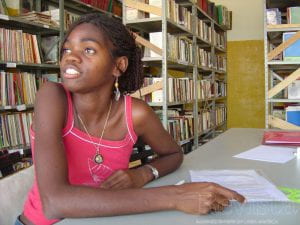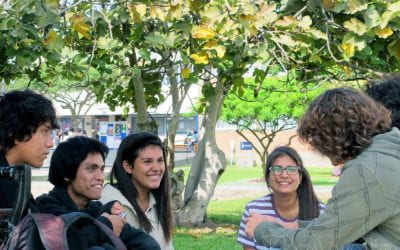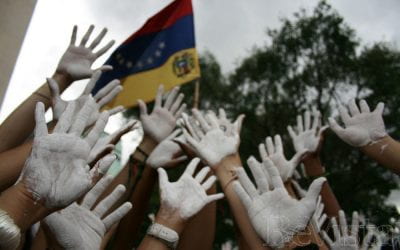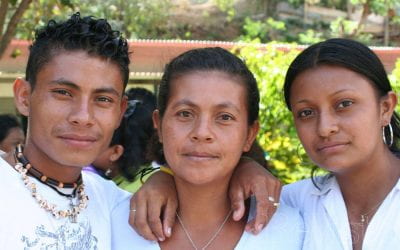Affirmative Action in Brazil

Students benefit from affirmative action program at UFBA and throughout Brazil. Photo from ReVista Archives.
The Brazilian Congress approved a bill in August imposing a quota of 50 percent of all available slots in federal universities for students coming from public schools, with the ethnic component within this quota matching that of the state in which the university is located. This system is precisely the one implemented at UFBA. The law will become effective next year and affect more than 90 federal higher education institutions and almost 2 million students.
In 2002, I was at Harvard as a Pan American Health Organization Fellow in the Center for Health and Society, doing research with epidemiology professor Ichiro Kawachi on health inequalities. Back home, a group of colleagues nominated me as candidate for Reitor (head) of my university in Brazil and, although almost in absentia, we won the elections with a large majority of faculty votes (in Brazilian public universities, deans and presidents are elected with proportional voting of faculty, staff and students).
The Federal University of Bahia (UFBA) is located in Salvador, capital of the state of Bahia in the impoverished Northeast region. During colonial times, Salvador was the main port of entry for the slave trade from Africa. This deeply influenced Bahia’s cultural and demographic profile, and a large majority of its people have African ancestry. Most of Bahia’s 13 million citizens are poor and reside in low-income neighborhoods; only a few are middle-or upper-class people, and those are generally whites.
At the time of my nomination, UFBA was a middle-sized university of 20,000 students, the only federal institution of higher education in Bahia. Every year, we offered around 3,800 student slots in 55 professional courses and 750 slots in 61 postgraduate courses. Contrary to the local socio-demographic profile, non-black, elite families of Bahia made up our student body; no indigenous people had ever been admitted to the university. The poor were in the minority overall and virtually absent from more prestigious courses such as medicine and law. UFBA was not alone in being so segregated because, then as now, higher education in Brazil has been a very scarce and valuable social asset. In the year 2000, less than 3 percent of the population studied at the university level.
Cited in the Brazilian Constitution as a citizen’s right and a duty of the state, education is theoretically universal, but it is underfunded and has recognized deficiencies and imbalances. Indeed, the public school system contributes to the increasing social exclusion of the poor because of its low quality. Thus, in contemporary Brazil, a broader cycle of reproduction of social inequalities operates through education. Two vicious circles intertwine.
The first one is related to the nature of the Brazilian state, which ideally should be an equity-promoting institution, but is not. The poor majority of the population is forced to send its children to inadequate public elementary and middle schools, unable to guarantee their access to higher education. Middle-and upper-class families send their children to private schools for basic education of better quality. Having more financial and technological resources, private high schools are more efficient in preparing students to pass the highly competitive test known as the Vestibular required to enter public universities. Poor youngsters who have attended low quality, underfunded public schools and, against the odds, manage to complete secondary education, have less probability of passing the exam. The entrance exam, in this vicious circle, functions as an instrument for selective social exclusion. The middle and upper classes therefore occupy most of the places in the prestigious courses of study in the best public institutions. For the poor, there only remain places in low prestige programs in public universities or, more frequently, in low quality, private institutions. This closes the first circle.
A second vicious circle of social perversion reinforces this inequity. In Brazil, public education is totally free, even for the rich who could afford paying tuition and fees, and at the university level, these are precisely the ones that offer better quality teaching. With tax incentives, well-to-do students have their university professional training fully supported by the government, and thus they accumulate more and more political capital. Closing the loop, the reproduction of social inequality is achieved when these young people themselves become the dominant minority that control companies, schools and governments, thus feeding back the process. Conversely, the poor have to pay for their university professional training in tuition-based private institutions of higher education. Given such unfair conditions, poor youth graduate with prospects for lower income, higher unemployment and, eventually, social exclusion.
Recent democratic governments in Brazil have implemented three types of public policies to reduce inequality. First, broader social policies, such as conditional cash redistribution and similar programs, aim at the most central of these inequities, the concentration of income. The second dimension comprises universal educational policies, including investments to improve public education, both in terms of quality and coverage. In a third dimension, specific and focused policies, involving redistributive or compensation programs, have been designed to complement universal policies.
In 2004, public universities in Bahia and in Rio de Janeiro first implemented affirmative action programs that included drastic interventions in selection processes such as social and racial quotas. Other institutions followed their pioneering examples. Today, 38 federal universities and eight state universities offer programs of social inclusion with different strategies of positive discrimination. The national media, representative of the dominant middle-class ideology, have promoted a public opinion campaign against affirmative action based on social origin and race-ethnicity. Recently, the Brazilian Supreme Court, in a striking, almost unanimous decision, voted that quotas in higher education were constitutional.
Brazilian universities have four types of social inclusion programs:
1. Extra points in the Vestibular score, based on public school attendance and racial origin (prevalent in state universities of São Paulo);
2. Ethnic and racial quotas, with
definition of race by a verification committee (implemented by the
University of Brasília);
3. Racial quotas, with self-definition, parallel to social quotas (predominant in Rio de Janeiro state universities);
4. Social quotas for public schools students, by course, with nested ethnic and racial quotas (the UFBA model).
Since 2003, UFBA has opened more opportunities to students from backward regions and socially disadvantaged backgrounds who have reached educational standards for higher education. With this aim, the university implemented three converging programs: additional student slots through new campuses and courses in regions outside the state capital; quotas for public school students, favoring poor blacks and indigenous candidates; and introduction of a new curriculum structure.
The quota system was approved in 2004 with the following design: 45 percent of the slots filled by students who attended secondary education in the public sector: of these, 85 percent reserved for blacks and 2 percent for indigenous applicants. Already in the first year of the quotas, UFBA recruited a number of blacks that was practically equivalent to their relative number in the population of Bahia. Before then, 30 percent of those admitted came from public schools; in 2005 this number increased to 51 percent, today it is around 66 percent. The first cohorts of quota students have graduated from several courses at UFBA. Evaluation studies reveal that the quota students’ relative performance is at least as good as that of those who have entered through general selection.
In addition to restricted and socially selective access, the university system of Brazil is oriented by educational paradigms outdated in many aspects: academic, professional and institutional. A fragmented conception of knowledge prevails in our higher education system, inherited from the old faculty system and reinforced by the 1968 university reform conducted by the military dictatorship. In Brazilian universities, general education and some contemporary fields of knowledge are missing because we never had an academic architecture that could foster the intellectual background needed for a multidimensional understanding of the world, society and history.
This has produced serious academic problems that need to be urgently addressed. On the one hand, predominance of professional training makes the
university not responsible for the baseline education of its students. With the direct entry into university-level professional courses, at age 16 or 17, people are too young to make a decision about their lifelong career. The choice of career is above all subjected to the socially exclusionary selection system to enter the university. At the same time, the exhaustion of the prevailing vocational university model in Brazil is evident. A strong disciplinary bias, choice of professional careers made too early, high dropout rates of students due to disenchantment with studies, mismatch between the rigidity in curricula and the broadness and diversity of skills demanded by the labor world, are problems that, to be overcome, require more comprehensive, flexible education models.
Maintaining its current curriculum structure places Brazil at serious risk of scientific, technological and intellectual isolation in the increasingly globalized world. After the creation of the U.S. and Canadian college systems and upon completion of the Bologna Process, which started in 1999, unifying the system of higher education in the European Union, there will be almost complete incompatibility between the Brazilian model of university education and those existing in other parts of the world, especially in developed countries.
In 2008, Brazil’s Ministry of Education began to promote a university reform with an accompanying investment plan called REUNI (Program for Restructuring and Expansion of Federal Universities). The major objectives of this reform are:
- Expanded enrollment, with territorial and social inclusion;
- Expansion of funding and investments for public universities;
- Increase of teaching staffs;
- New forms of selection processes;
- Restructuring curricula;
- Revision of post-graduate programs.
After a long debate, the National Secondary Education Exam (ENEM) was restructured, aiming at replacing the Vestibular as the entrance examination for higher education. The Ministry of Education broadened the scope and scale of the exam to make it a tool for selecting candidates based on their potential and aptitude rather than on the amount of information stored. In addition, a digital platform provides a unified on-line selection system, where the applicant introduces ENEM scores for multiple and flexible choices of educational institutions. Despite a series of logistical problems widely exploited by the press, this year 6.5 million people registered for the ENEM, which was adopted by 56 universities for the purpose of candidate selection.
At UFBA, using REUNI funds, we implemented a curriculum of learning cycles, compatible with the U.S. and Canadian university systems and the Bologna model in Europe. It includes a new kind of undergraduate course: the Interdisciplinary Bachelor (BI). The first-cycle BI offers a curriculum based on strong conceptual, ethical and cultural underpinnings, combined with a set of cross-technical skills, abilities and attitudes. A second cycle of studies is devoted to professional training in specific fields. The third cycle comprises post-graduate degree courses. Since then, 15 other federal and state universities have adopted similar models of curricular innovation.
Some of Brazil’s academic establishment, led by traditional faculties, defensively reacted against proposals for the transformation of higher education of this type and, therefore, have tended to reject innovative models such as the BI project. They are representative of the structure of isolated, semi-autonomous vocational schools and faculties that, although characteristic of the old Brazilian universities, oppose building new forms of professionalism based on sharing, solidarity and social commitment that transcend corporate disciplinary boundaries.
The adoption of first-cycle undergraduate studies for all university students means they experience a common learning process with shared goals. This program exposes them to scientific, political, environmental and social questions, enhancing their understanding of their role in contemporary society and their participation as citizens. An immediate benefit is enrollment in professional courses by more mature students, aware of their vocation, capable of critically analyzing decisions, carrying humanitarian, artistic and social attitudes and values. In strictly academic terms, the new model seeks to form a new student-professional profile, able to continually learn, understand and critically analyze scientific knowledge, skilled technically, but not alienated from humanistic, ethical and political issues. By understanding, during university education, how socio-cultural issues interact with work and life, students will be more respectful of community knowledge fundamental for achieving sustainable changes in society.
Re-elected in 2006, I was President of UFBA until 2010. I have witnessed a profound and broad change on the scene of higher education in Bahia and in Brazil. The State of Bahia now has five federal universities, all but one of them evolved from UFBA; together, they offer four times as many student slots as UFBA did alone 10 years ago. And the country as a whole has rapidly expanded higher education,doubling the enrollment in public institutions. As a result, in 2010, 13 percent of the 18 to 25 age group were in universities; now, 8 percent of the total population have a university degree compared to 4.4 percent in 2000. Today, with a student body of 40,000 people, UFBA is a university much larger and with more diversity than before; currently, we offer over 10,000 places for entering students (1,600 in four undergraduate BI programs, 6,700 in 109 professional degree programs and 1,900 in 103 postgraduate courses). The student body now has a majority of students of African heritage, mostly from poor families from all over Bahia; and, although still in small number, Indian students from several Bahian tribes are graduating in many professional courses. The poor are now represented significantly in each and every course of UFBA, including those of higher social prestige.
We have made some progress, undeniably. But there is still so much to achieve. For too long, society and state in Brazil have made education not an element of social inclusion – which would be the duty of a democratic state as it is a right for all – but rather a tool for the reproduction of social inequalities. Those who struggle to turn the University into a means for social transformation need to tackle the problem of inequity reproduced by the educational system. This is urgent and crucial, because in Brazil, unlike in other parts of the world, instead of a pathway to equity, education has been one of the main levers of a deeply perverse mode of construction and reproduction of an unequal and unjust society. Although recent initiatives of affirmative action and curriculum innovation for social responsibility have been successful in many public universities in Brazil, they have not yet spread wide enough to make a difference, given the magnitude of the social education debt resulting from the Brazilian heritage of colonial slavery.
Fall 2012, Volume XII, Number 1
Naomar Almeida-Filho, former president of the Universidade Federal da Bahia, Brazil, is a professor of epidemiology at the Instituto de Saúde Coletiva at UFBA.
Related Articles
University Lessons: Editor’s Letter
I learned about universities on the barricades. Well, not exactly. I was a philosophy student at Barnard—the women’s college at Columbia University—when the uprising began in 1968. Students, including my boyfriend and several classmates, took over buildings to protest…
The Last Word
More than twice as many Latin Americans are attending institutions of higher education than two decades ago, and the number will continue to increase as more students graduate from secondary schools. ReVista’s timely focus on higher education is thought-provoking…
Making a Difference: A Problem With the UN Millennium Goals
Every Saturday for two years, Estevana Sánchez walked through the jungle for miles, in the dark, crossing a river in the rainy season, to finish high school. Her five teenage children did the same. At the end of the trail, they took a long bus ride to the town of San Juan del Sur…




